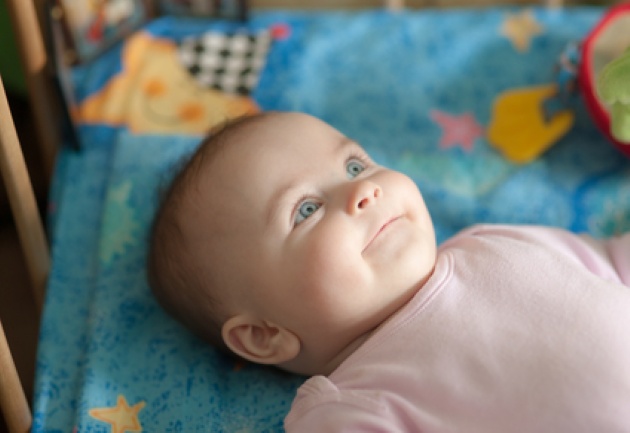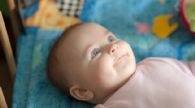To put the odds in
favor of your baby, there are four steps that you can take to help create a
safe sleep environment for your baby;
· Provide a smoke-free environment – both
before and after birth.
· Always place your baby on his or her back to
sleep – night time and nap time.
· Place your baby to sleep in a crib next to
the adult’s bed for first 6 months.
· Provide a safe crib environment that has
no toys or loose bedding.
Smoke-Free
Smoking during pregnancy
exposes unborn babies to tobacco smoke which is one of the greatest risks for
SIDS. Up to 1/3 of all SIDS deaths could be prevented if pregnant women
did not smoke. No smoking at all is best for your baby, but lowering the amount
of cigarettes you smoke can also lower the risk of SIDS.
Second-hand smoke also
increases the risk of SIDS after your baby is born. Avoid
smoking near your baby - in the house, in the car or anywhere your baby sleeps
or spends time. If you, your partner, family member or friends smoke, smoke
outside and far away from your baby.
Help to quit smoking is
available from your health practitioner or by contacting Health Canada at
1-866-366-3667.
Breastfeeding
Any
amount of breastfeeding for any duration can help protect your baby from SIDS;
but exclusive breastfeeding for the first 6 months (when the risk of SIDS is
highest) can lower the risk of SIDS by up to 50<>percentage<>.
Reminder; If
you bring your baby into bed to breastfeed, the risk of SIDS and suffocation do
not increase so long as you place your baby back to sleep in a crib, cradle or
bassinet after the feeding.
Back to Sleep
Babies who always sleep on
their backs have a lower risk of SIDS. Placing your baby on his
or her back to sleep works; since the launch of the 1999 Back to Sleep
campaign in Canada, the number of parents and caregivers who placed their
babies on their backs to sleep increased dramatically, and the rate of SIDS has
dropped by more than half.
Newborn babies get in the
habit of sleeping the way they are first placed, so start placing your baby on
his or her back to sleep right after he or she is born. Sleep positioners, such
as rolled up blankets or wedges that are meant to keep babies on their backs to
sleep are not needed and can increase the risk of suffocation.
Supervised tummy time
during play time is important to develop healthy muscles and helps to prevent
your baby from developing plagiocephaly, also known as flat head.
Reminder;
Place your baby on his or her tummy 2-3 times a day soon after he
or she is born. Slowly work your way up from 1 minute of tummy time, each time
until your baby can hold up his or her own head, often around 3-4 months.
Why naptime and night time?
Babies who usually sleep on
their backs but are then placed on their tummies to sleep are at a much higher
risk of SIDS. For this reason, it is important that you, your partner, family,
friends and caregivers know to always place your baby on his or her back to
sleep - at home, in child care settings and when travelling.
As babies get older they
are usually able to turn over onto their tummies by themselves, often around 5
months. When this happens you do not have to reposition your baby onto his or
her back to sleep.
Safe Sleep
The safest place for your
baby to sleep or nap is in a crib, cradle or bassinet that meets current
Canadian safety regulations. When babies sleep in places that are not made
for them, such as on an adult bed, sofa or armchair, they can become trapped
and suffocate. The risk of suffocation is even higher if a baby shares the same
sleep surface with an adult or another child.
Safe Sleep
environment![]() Other
than a firm mattress and a fitted sheet, there is no need for any extra items
in the crib, cradle or bassinet
Other
than a firm mattress and a fitted sheet, there is no need for any extra items
in the crib, cradle or bassinet![]() Soft
bedding, such as pillows, comforters, quilts and bumper pads, can increase the
risk of suffocation
Soft
bedding, such as pillows, comforters, quilts and bumper pads, can increase the
risk of suffocation![]() Soft
surfaces, such as adult beds, sofas and armchairs, can increase the risk of
suffocation
Soft
surfaces, such as adult beds, sofas and armchairs, can increase the risk of
suffocation
Safe crib, cradle or
bassinet![]() Check for
a label that shows the date it was made. If it does not have a label, it may
not be safe
Check for
a label that shows the date it was made. If it does not have a label, it may
not be safe![]() Check
regularly to make sure that the hardware is tight and not damaged
Check
regularly to make sure that the hardware is tight and not damaged![]() Health
Canada only recommends cribs made after 1986 and/or no more than 10 years old
Health
Canada only recommends cribs made after 1986 and/or no more than 10 years old
To learn more about crib,
cradle and bassinet safety, please visit Health Canada
Consumer and Product Safety.
Baby swings, bouncers,
strollers and car seats are not made for unsupervised sleep. Sleeping in a
sitting position can cause your baby's head to fall forward which can make it
hard for your baby to breathe. For this reason it is important to move your
baby to a crib, cradle or bassinet to sleep or when you arrive at your
destination.
Overheating is a risk for
SIDS![]() Your baby
is safest when he or she sleeps in fitted one-piece sleepwear that is
comfortable at room temperature and does not cause your baby to overheat
Your baby
is safest when he or she sleeps in fitted one-piece sleepwear that is
comfortable at room temperature and does not cause your baby to overheat![]() If the
room temperature is comfortable for you, then it is comfortable for your baby
If the
room temperature is comfortable for you, then it is comfortable for your baby ![]() Babies do
not need extra blankets because a baby's movements can cause their head to
become completely covered, which can cause them to overheat
Babies do
not need extra blankets because a baby's movements can cause their head to
become completely covered, which can cause them to overheat
Reminder; If a
blanket is needed, your baby is safest with a thin, lightweight and breathable
blanket.
Crib,
Cradle or Bassinet next to your bed
Room sharing for the first
6 months (when the risk of SIDS is highest) helps your baby sleep safely and
lowers the risk of SIDS. Room sharing means placing your baby to sleep
in a crib, cradle or bassinet next to your bed, in your room.
Bed sharing or co-sleeping
is when a baby shares the same sleep surface, such as an adult bed, sofa or
armchair, with an adult or another child. Sharing the same sleep surface
increases a babies risk of SIDS and suffocation. This risk is ever higher for
babies less than 4 months old.
Sharing the same sleep
surface is unsafe because a baby can suffocate if; he or she
becomes trapped between the sleep surface and the body of an adult or another
child, the wall or other objects
an adult
or another child rolls over onto the baby; or
the sleep
surface has soft bedding, such as pillows, comforters or quilts
The risk of SIDS and
suffocation is even higher if a baby shares the same sleep surface with a
parent or caregiver who smokes, is very tired, or has taken drugs, alcohol or
medications that can make them sleepy.
Parents and all caregivers
can create a safe sleep environment at home, in childcare settings and when
travelling.

 In The Latest Issue:Latest Issue:
In The Latest Issue:Latest Issue:
- A Bittersweet Farewell
- The new Laval Aquatic Co...
- The End of an Era:
Articles
Calendar
Virtual- ANNUAL TEACHER APPRECIATION CONTEST
- APPUI LAVAL
- ARTS & CULTURE
- CAMPS
- CAR GUIDE
- CCIL
- CENTENNIAL ACADEMY
- CHARITY FUNDRAISING
- CITYTV
- COSMODÔME
- COMMUNITY CONNECTIONS
- COVER STORY
- DINA DIMITRATOS
- ÉCOLE SUPÉRIEURE DE BALLET DU QUÉBEC
- EDITORIALS
- ÉDUCALOI
- EDUCATION
- EMPLOYMENT & ENTREPRENEURSHIP
- FÊTE DE LA FAMILLE
- FÊTE DU QUARTIER SAINT-BRUNO
- FAMILIES
- FESTIVAL LAVAL LAUGHS
- FÊTE DE QUARTIER VAL-DES-BRISES
- FINANCES
- GLI CUMBARE
- GROUPE RENO-EXPERT
- HEALTH & WELL-BEING
- 30 MINUTE HIT
- ANXIETY
- CHILDREN`S HEALTH & WELLNESS
- CLOSE AID
- DENTAL WELLNESS
- EXTREME EVOLUTION SPORTS CENTRE
- FONDATION CITÉ DE LA SANTÉ
- GENERAL
- HEARING HEALTH
- MESSAGES FROM THE HEALTH AGENCY OF CANADA
- MENTAL HEALTH
- SEXUALITY
- SOCIAL INTEGRATION
- SPECIAL NEEDS
- TEENS
- THE NUTRITION CORNER
- THE NUTRITION CORNER - RECIPES
- VACATION DESTINATION
- WOMEN'S FITNESS
- WOMEN'S HEALTH
- HILTON MONTREAL/LAVAL
- HOME & GARDEN
- INTERNATIONAL WOMEN'S DAY
- JAGUAR LAVAL
- LAVAL À VÉLO
- LAVAL FAMILIES TV SHOW
- LAVAL FAMILIES MAGAZINE CARES
- LAVAL URBAN IN NATURE
- LE PARCOURS DES HÉROS
- LES PETITS GOURMETS DANS MA COUR
- LEON'S FURNITURE
- LEONARDO DA VINCI CENTRE
- LFM PREMIERES
- LIFE BALANCE
- M.P. PROFILE
- MISS EDGAR'S AND MISS CRAMP'S SCHOOL
- MISSING CHILDREN'S NETWORK
- NETFOLIE
- NORTH STAR ACADEMY LAVAL
- OUTFRONT MEDIA
- PASSION SOCCER
- PARC DE LA RIVIÈRE-DES-MILLE-ÎLES
- PÂTISSERIE ST-MARTIN
- PIZZERIA LÌOLÀ
- PLACE BELL
- PORTRAITS OF YOUR MNA'S
- ROCKET DE LAVAL
- SACRED HEART SCHOOL
- SCOTIA BANK
- SHERATON LAVAL HOTEL
- SOCIÉTÉ ALZHEIMER LAVAL
- STATION 55
- STL
- SUBARU DE LAVAL
- TECHNOLOGY
- TEDXLAVAL
- TODAY`S LAURENTIANS AND LANAUDIÈRE
- TODAY`S LAVAL
- WARNER MUSIC
- THIS ISSUE
- MOST RECENT
Magazine
Keeping baby safe, with your eyes closed
Did you know that Sudden Infant Death Syndrome (SIDS) can occur at any time during the first year of life but peaks between 2 and 4 months, with fewer SIDS deaths occurring after 6 months?
Articles ~e 105,7 Rythme FM 4 chemins Annual Teacher Appreciation Contest Appui Laval Arts & Culture Ballet Eddy Toussaint Camps THIS ISSUE MORE...
CONTESTS Enter our contests
CONTESTS Enter our contests
CALENDAR
Events & Activities
COMMUNITY Posts Events
PUBLICATIONS Our Magazine Family Resource Directory
LFM BUSINESS NETWORK Learn more
COUPONS Click to save!
COMMUNITY Posts Events
PUBLICATIONS Our Magazine Family Resource Directory
LFM BUSINESS NETWORK Learn more
COUPONS Click to save!
SUBSCRIPTIONS
Subscribe to the magazine
Un-Subscribe
E-NEWSLETTER Subscribe to our E-newsletter Un-Subscribe
WRITE FOR US Guidelines & Submissions
POLLS Vote today!
E-NEWSLETTER Subscribe to our E-newsletter Un-Subscribe
WRITE FOR US Guidelines & Submissions
POLLS Vote today!
ADVERTISERS
How to & Media guide
Pay your LFM invoice
SUGGESTIONS Reader's Survey Suggest a Listing
LFM About Us Our Mission Giving Back Contact Us
SUGGESTIONS Reader's Survey Suggest a Listing
LFM About Us Our Mission Giving Back Contact Us
 PICK-UP LOCATIONS
Get a copy of LFM!
PICK-UP LOCATIONS
Get a copy of LFM!
TERMS & CONDITIONS Privacy | Terms
ISSN (ONLINE) 2291-1677
ISSN (PRINT) 2291-1677
Website by ZENxDESIGN



 BY:
BY: 
Tweet
Share